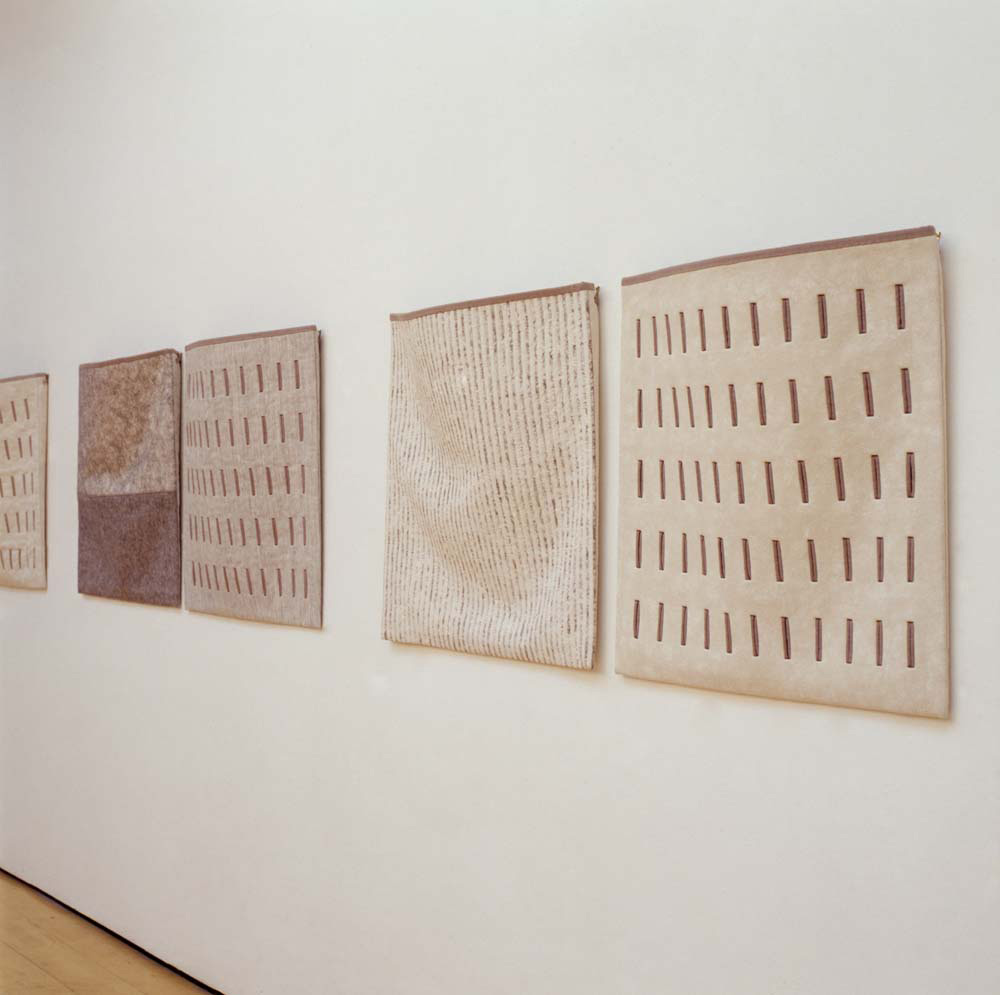2 - material multiples: from inner to outer relationships
This body of studio enquiry extends the smaller series of cloth constructed ‘bag’ forms to consider the potential of larger multiples. Developing from what were initially small-scale singular forms, the work had gradually increased both in the size and the number of module units with the intention of achieving a larger surface area and thereby material presence. However, as the size increased, the challenge was how to maintain the insistence on the surface. Concerned that the bags were becoming too monumental and thereby losing their important relationship to the body and conscious of the difficulties of sustaining the surface over a larger scale, rather than increase the size, subsequent series began to address the possibility of much larger multiples. In 18 x 51 over 11.44 (2002), the whole gallery wall was curtained with eighteen long thin bag forms; and in Double-lined: 198 x 82 (2007), twenty-seven draped forms lined the entire room.
This change of approach, initially instigated by the more reductive Doing without: sustaining 7 square metres (1999), prompted a corresponding shift in focus from inner to external relationships, as the work moved into the realm of installation and both the space of the gallery and the body of the viewer began to be articulated in a much more pronounced way. In the tension between an insistence on surface and the three-dimensional object-nature of their form, the emerging practice found resonances with many of the debates in the 1960’s and 70’s, that surrounded the paradoxical nature of monochrome painting and issues of objecthood. As Lucy Lippard in her essay The Silent Art observes: ‘(w)hen the expanse of an uninflected single surface gives way to the silhouette, the wall becomes the ground, or field, and the canvas itself becomes an image, a three dimensional version of the hard-edge painted image.’1 Through the time taken to perceive and absorb the play of light over its subtlety modulated surfaces, the monochrome clearly exploits the material and psychological experience of perception and is often equated with the metaphysical and immaterial. However, in its rejection of illusionistic devices, the monochrome also emphasises the painting’s material presence as concrete object and the subsequent artificiality of a modernist aesthetic which detaches the artwork from its context.
Concerns about the tension between the optical and tactile dimensions of the work also found resonances with Rosa Lee’s essay Threads. As part of a broader interrogation of the practices and politics of women's contemporary painting, Lee focuses on a number of artists whose work she describes as presenting ‘characteristics that exceeds the purely visual and relate to somatic senses of touch, rhythm and gesture.’ **
* Lucy R. Lippard (2002) The silent art. In: Colpitt, F. ed. Abstract art in the late twentieth century. Cambridge: Cambridge University Press. p.58
Rosa Lee (2004) Threads. In Rosemary Betterton ed. Unframed: practices and politics of women's contemporary painting. London, New: I.B. Taurus & Co Ltd. p.6
See also:
- Bristow, M. (2005) Sustaining 7 Square Metres. In: Revealed. Nottingham: Nottingham Castle Museum and Art Gallery.
- Bristow, M. (2010) Materialising the grid: correspondences, contradictions and conventions. Unpublished manuscript.













